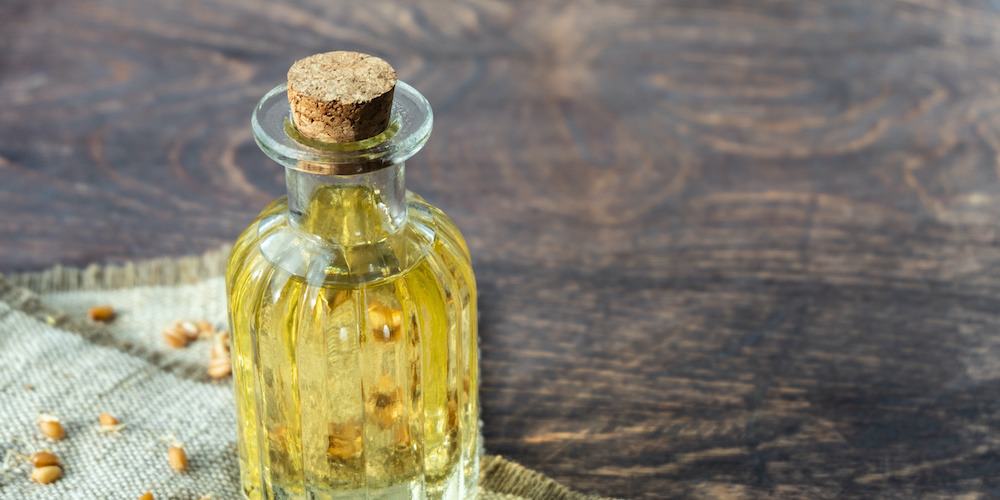The benefits of wheat germ oil
Wheat germ oil, what is it ?
Avec le son et l’amande, le germe constitue le grain de blé (Triticum). Aussi appelé « embryon », il renferme une grande quantité d’huiles et d’acides gras.
Once separated, it can be processed into shavings, flakes, or vegetable oil. In that case, the precious wheat germ oil is obtained from the wheat germ.
It is distinguished by a beautiful dark yellow color with orange tones. It has a characteristic scent and a pronounced cereal aroma.
Useful in cooking, it is also recommended for skin and hair care. It can also be taken in capsules as a dietary supplement.
The benefits of wheat germ
Le germe est la partie la plus petite mais la plus nutritive du grain de blé. Et pour cause : c’est à partir de lui qu’apparaîtra une nouvelle plante. Elle doit donc trouver en lui les nutriments nécessaires à sa croissance.
It contains, in particular, a large amount of vitamin E (16 mg per 100 g), which is present in the oils and fatty acids (omega-3-6-9) of the germ.
It also contains provitamin A (beta-carotene) and vitamins B, C and E. On the mineral side, it is rich in iron, magnesium and zinc.
Finally, this oil is one of the few to contain octacosanol, a natural compound beneficial for the heart. Therefore, it is recommended for the prevention of cardiovascular disorders.
As shown in this study, it also has an antioxidant effect that protects the body from free radicals.
How to choose your wheat germ oil?
Choose a certified organic oil
As with all vegetable oils, ideally you should choose an organic wheat germ oil. Organic certification guarantees wheat grown under optimal conditions, without pesticides or chemicals.
Dans ce cas, l’huile ne contient aucun résidu nocif. Elle doit aussi être 100 % vierge, sans OGM, sans additifs ni conservateurs.
In France, wheat is the most widely grown cereal but also the most chemically treated. By favoring organic farming, you contribute to the preservation of the environment.
Other quality criteria
Choose a vegetable oil obtained from a first cold pressing (or cold-extracted). This process, carried out at room temperature, preserves the active ingredients and properties of wheat germ. That way, you can be sure to choose a very high-quality oil.
If you can, buy an oil made from wheat germ of French origin and grown locally.

How to use wheat germ oil?
In cooking
It has a distinctive aroma that is both mild and fragrant. It is appreciated for its pleasant cereal-like, biscuity taste close to hazelnut. In cooking, it is ideal for seasoning cold dishes: salads, sauces, vinaigrettes…
However, it is not suitable for cooking or frying. Its fatty acids and antioxidants do not withstand heat. You would therefore lose all nutritional value.
This oil is sensitive to oxidation and goes rancid quickly. Once opened, store it away from light and in the refrigerator. It should be consumed within 3 months.
As a dietary supplement
To enjoy its benefits, you can take it as a dietary supplement. The oil is offered in capsules, to be taken with meals. This form has the advantage of being tasteless.
So it will suit people who don’t like the flavor of wheat germ oil. Encapsulation also protects the oil from oxidation.
For skin care
Thanks to its richness in vitamin E and antioxidants, it protects the skin from free radicals. It prevents premature aging, slows the appearance of wrinkles and signs of aging.
It also promotes cell regeneration, nourishes, and restores suppleness and elasticity. It is ideal for caring for dry and mature skin.
You can apply directly a few drops to the face and/or body. It pairs well with other vegetable oils: hemp oil, apricot kernel oil, argan oil…
Its thick, creamy texture is well suited to body massages. It helps tissue repair, reduces stretch marks and promotes healing.
For hair care

Its essential fatty acids strengthen the hair fiber and limit hair loss. They stimulate microcirculation in the scalp and promote hair growth.
Wheat germ oil provides hydration, shine, softness and suppleness. It is particularly suitable for color-treated, dry, and coily hair.
Apply it as an oil bath, alone or combined with another vegetable oil (castor, coconut, avocado, argan…). It is also suitable for hair masks.



